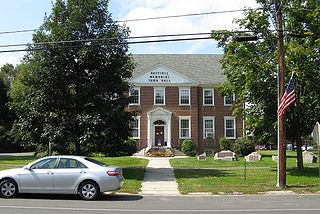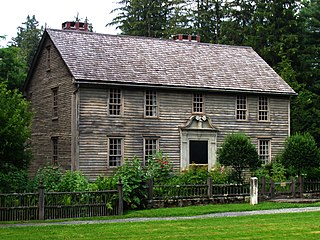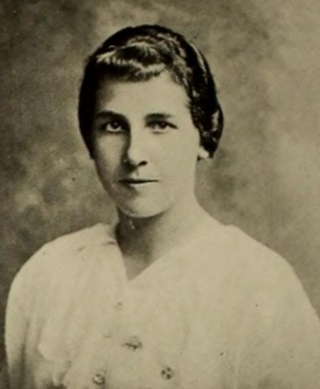
Amherst is a city in Hampshire County, Massachusetts, United States, in the Connecticut River valley. Amherst, with a council–manager form of government, is considered a city under Massachusetts state law. Amherst is one of several Massachusetts municipalities that have city forms of government but retain "The Town of" in their official names. At the 2020 census, the population was 39,263, making it the highest populated municipality in Hampshire County. The town is home to Amherst College, Hampshire College, and the University of Massachusetts Amherst, three of the Five Colleges.

Hampshire County is a historical and judicial county located in the U.S. state of Massachusetts. As of the 2020 census, the population was 162,308. Its most populous municipality is Amherst, its largest town in terms of landmass is Belchertown, and its traditional county seat is Northampton. The county is named after the county Hampshire, in England. Hampshire County is part of the Springfield, MA Metropolitan Statistical Area. Together with Hampden County, Hampshire County municipalities belong to the Pioneer Valley Planning Commission.

Whately is a town in Franklin County, Massachusetts, United States. The population was 1,607 at the 2020 census. It is part of the Springfield, Massachusetts Metropolitan Statistical Area.

Hadley is a town in Hampshire County, Massachusetts, United States. The population was 5,325 at the 2020 census. It is part of the Springfield, Massachusetts Metropolitan Statistical Area. The area around the Hampshire and Mountain Farms Malls along Route 9 is a major shopping destination for the surrounding communities.

The city of Northampton is the county seat of Hampshire County, Massachusetts, United States. As of the 2020 census, the population of Northampton was 29,571.

Hatfield is a town in Hampshire County, Massachusetts, United States. The population was 3,352 at the 2020 census. It is part of the Springfield, Massachusetts Metropolitan Statistical Area. The census-designated place of Hatfield consists of the town center and surrounding areas.

The Pioneer Valley Transit Authority (PVTA) oversees and coordinates public transportation in the Pioneer Valley of Western Massachusetts. Currently the PVTA offers fixed-route bus service as well as paratransit service for the elderly and disabled. The PVTA was created by Chapter 161B of the Massachusetts General Laws in 1974. It is based in Springfield, Massachusetts, serves Hampden and Hampshire counties, and provides connecting service to the FRTA in Franklin County and to the WRTA in Worcester County. It is the largest regional transit authority, and second largest public transit system in Massachusetts after the Massachusetts Bay Transit Authority, providing service to over 11 million riders annually across 24 municipalities in the region, with about 70% of all riders using the system as their primary mode of transit.

Sophia Smith founded Smith College in 1870 with the substantial estate she inherited from her father, who was a wealthy farmer, and six siblings.

Laurenus Clark Seelye, known as L. Clark Seelye, was the first president of Smith College, serving from 1873 to 1910. He graduated from Union College (NY) in 1857 with Phi Beta Kappa honors and membership in The Kappa Alpha Society. Seelye later studied at Andover Theological Seminary and the Universities of Berlin and Heidelberg. After serving as a Congregational Minister in Springfield, Massachusetts, he became Williston Professor of Rhetoric, Oratory and English Literature at Amherst College, where his brother Julius was Professor of Mental and Moral Philosophy. Under President Stearns, Amherst College in 1865 had 17 faculty and 203 students. Seelye taught at Amherst from 1865 until his election as President of the newly formed Smith College in nearby Northampton, Massachusetts in 1873.

The Mill River is a 13.5-mile-long (21.7 km) tributary of the Connecticut River arising in the western hilltowns of Hampshire County, Massachusetts. It is notable for dropping in elevation, along with its West Branch, more than 700 feet (210 m) over 15 miles (24 km).

The Mission House is an historic house located at 19 Main Street, Stockbridge, Massachusetts. It was built between 1741 and 1742 by a Christian missionary to the local Mahicans. It is a National Historic Landmark, designated in 1968 as a rare surviving example of a colonial mission house. It is now owned and operated as a nonprofit museum by the Trustees of Reservations.

Pat Schneider was an American writer, poet, writing teacher and editor.

The Norwin S. and Elizabeth N. Bean Foundation is a general purpose charitable foundation, which makes grants in the fields of arts and humanities, education, environment, health, human services, and public/ society benefit in New Hampshire.

The Porter–Phelps–Huntington House, known historically as Forty Acres, is a historic house museum at 130 River Drive in Hadley, Massachusetts. It is open seasonally, from May to October. The house contains the collection of one extended family, with objects dating from the seventeenth to twentieth centuries. It was occupied from its construction in 1752 until the 1940s, when a member of the eighth generation of the family in the house turned it into a museum. Its collection is entirely derived from the family, and the extensive archives, including the original diary of Elizabeth Porter Phelps, are held at the University of Massachusetts Amherst. The house was added to the National Register of Historic Places in 1973, and is a central feature of the Forty Acres and Its Skirts Historic District, designated in 2023.

Hopkins Academy is the public middle and senior high school for the town of Hadley, Massachusetts, United States.
Smith Vocational and Agricultural High School is a four-year Career/Technical High School located in Northampton, Massachusetts, United States. Smith Vocational and Agricultural High School is a public high school for residents of Northampton and tuition students from all of Hampshire County. Students spend alternating weeks in shop and academic programs as they prepare for both a high school diploma and a Certificate of Occupational Proficiency. The school is accredited by the New England Association of Schools and Colleges, and all shop programs meet state standards for vocational education programs.

Roswell Field Putnam (1840–1911) was the foremost residential architect in Amherst and Northampton, Massachusetts, in the last two decades of the 19th century. He designed more than 35 sizable houses in those two towns and several in nearby communities.
Helen Rand Thayer was an American suffragist and social reformer. A pioneer in the settlement movement era, she was a co-founder and president of the College Settlements Association (CSA). She was also an alumnæ trustee of Smith College.

Abby Snow Belden was an American physical educator, on the faculty at Smith College. She was an accomplished horsewoman and active in hiking, camping, and other outdoors activities in New England.


















